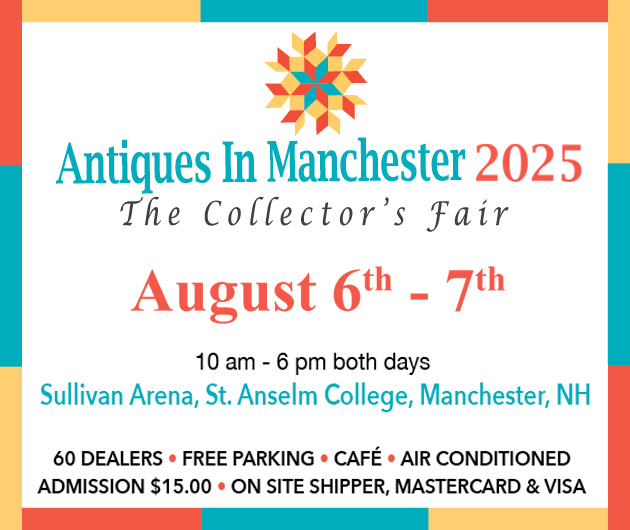The Andy Williams Folk Art Collection and Other Good Stuff
March 3rd, 2013
|
The pair of Ward brothers (Lemuel T. and Stephen) widgeon decoys had “Mackey Collection” stamps. William F. Mackey Jr. was the author of American Bird Decoys (Bonanza Books, 1965), where the drake of this pair is illustrated on page 147. Mackey’s superlative collection was sold in the 1970’s through the Richard Bourne auction house in Hyannis, Massachusetts, in eight sessions over two years. This pair of decoys in worn, original paint was pursued by four or five phone bidders who pushed the selling price to $132,000. Andy Williams collection.
Ammi Phillips painted this portrait of identical twins Jacob Wessel and William Henry Ten Broeck in Clairmont, New York, in 1834, when the boys were ten years old. The 30¼" x 50¼" oil on canvas sold to dealer David Schorsch for $880,000. Read the story for more information. Andy Williams collection.
The View of the Buildings & Surroundings of the Berks County Almshouse is an oil on zinc panel, painted by John Rasmussen, a resident there from 1879 to his death in 1895. It brought $102,000 from a phone bidder. Several versions of this scene by Rasmussen are known. In October 2008 at a Pook & Pook sale of the Richard and Rosemarie Machmer collection in Downingtown, Pennsylvania, one version brought $339,300 from a dealer. It was in the booth of Guy Bush of G.K.S. Bush, Inc. the following January at the Winter Antiques Show in New York City with a price tag of $575,000. Andy Williams collection.
This portrait of the sidewheeler steamboat Neversink was painted by James Bard in 1866. It’s a big canvas, 30½" x 50", and the rendering of the ship is crisp and clean. Auctioneer Stephen Fletcher was holding a strong left bid, and the painting went to that bidder for $108,000, well over the high estimate of $75,000. Bard painted another view of the Neversink, also dated 1866. The smaller version (28¼" x 42½") was sold by Sotheby’s on January 29, 1995, for the New-York Historical Society and brought $54,625. Andy Williams collection.
This 19th-century still-life painting attracted a lot of attention and admiration during the auction preview and achieved the second-highest price. Westborough, Massachusetts, dealer David Wheatcroft, bidding by phone, paid $480,000 for the 41½" x 43¼" oil on canvas. There are some tantalizing clues as to the artist, and Wheatcroft said he hoped to be able to learn more. Andy Williams collection.
Massachusetts dealer David Wheatcroft bought the view of The Junction formed in Medford by the meeting of the [Mystic] River, Canal, and Railroad. A note on the back of the 19¼" x 22½" painting indicated that it was done in 1835. Wheatcroft got a real gem for his client for $144,000. |
Skinner, Inc., Boston, Massachusetts
Photos courtesy Skinner, Inc.
It’s not difficult for Skinner auction regulars to know when something big is about to happen. All you have to do is watch the phone bidding bank and count phones to ears. When the number gets above 12, it’s time to pay attention. There were somewhere between 15 and 18 phones up at ear level when auctioneer Stephen Fletcher led off with the first lot of the Andy Williams (1927-2012) collection of folk art at 10 a.m. on Sunday, March 3.
That first lot, a pair of widgeon decoys by the Ward brothers of Crisfield, Maryland, opened for $10,000 and quickly shot to $110,000; with buyer’s premium the final cost was $132,000. (All prices noted will include a buyer’s premium of 20% on amounts up to $500,000, plus 12% on amounts over that figure.)
The folk art collection of one of America’s most celebrated performers was a tightly focused group of only 22 objects. Veteran collector and dealer Peter Tillou of Connecticut had assisted Williams in assembling his finely honed choices. (The only time we ever saw Andy Williams at an antiques show, he was with Peter Tillou.) One weathervane and one portrait by Erastus Salisbury Field did not sell, but the other 20 items did very well, bringing in a total of $2,471,725.
Many thought the best painting of the lot was a stark circa 1834 double portrait by Ammi Phillips (1788-1865) of the Ten Broeck twins of Columbia County, New York. The boys, dressed in white shirts and dark brown jackets, are seated in black and gilt-edged thumb-back chairs with a white ironstone platter of pears and peaches between them—all painted against a black background. Sotheby Parke Bernet had sold it almost 33 years ago on November 21, 1980, for $185,000 (a record at the time). Its exhibition history includes the Columbia County Historical Society in Kinderhook, New York, in 1975; the Whitney Museum of American Art in New York City in 1980; and in February of 1994, it was in a traveling exhibition, Revisiting Ammi Phillips: Fifty Years of American Portraiture, which opened at the Museum of American Folk Art, New York City, and went to San Diego, California, and to Chicago later that year.
Connecticut dealer David Schorsch showed up at Skinner’s Boston showroom in the midafternoon on the day prior to the auction and took the painting into a room to blacklight it. It had been restored in the mid-1980’s, and the restorer had wax-relined the canvas but wisely left windows in the new lining so the script identifying the sitters written on the rear of the original canvas remained visible.
Someone in the gaggle of dealers around the painting at the Saturday preview observed, “If it doesn’t bring a million bucks, there’s something wrong with this business.” It didn’t get to that number, but David Schorsch, bidding by phone, must have liked what he saw a day earlier, because he won it for $880,000.
“It was a buyer’s market,” Schorsch said later. “I was shocked to get it for that price. It was a very good day to buy, that’s all. It makes up for the times when you overpay.”
How does the portrait of the Ten Broeck twins compare to other paintings by Phillips? “If you make up a list of the ten best Ammi Phillips portraits, this painting would be near the top on everybody’s list,” Schorsch said. “If you consider that a sampler can sell for a million dollars, and I’ve paid that for one, then under the right circumstances, it would not be unusual to see this painting bring a multiple of its selling price.”
Schorsch said he had no buyer in his pocket when he bought it. “I may have someone in mind now, but presently it’s still for sale.”
Peter Tillou took a classic carved and painted tobacconist figure of a racetrack tout, possibly the work of Charles Dowler of Providence, Rhode Island, a known carver of sporting characters. The figure sold for $390,000.
Tillou also got a portrait by Ammi Phillips of a child in pink dress with her pet spaniel. He got this lot for $144,000 (est. $200,000/300,000). That price has to be considered a bargain. Other portraits by Phillips of children in red and pink dresses, with and without pets, have brought much, much more. For example, Northeast Auctions sold a Phillips painting with two children in its Egan sale in August 2006 and got $303,000 for it; Sotheby’s sold one with a girl, a dog, and a bird at its January 20 and 21, 2012, sale for $806,500; and Christie’s sold a girl and cat portrait at its January 18 and 19, 2007, sale for $1,248,000. There are more examples, but those are the nearest by date.
Dealer David Wheatcroft of Massachusetts underbid the Ten Broeck twins’ portrait by Ammi Phillips, but he succeeded on a really stunning still life painting. The almost square (41½" x 43¼") carefully composed oil on canvas still life depicts carefully composed fruit and flowers, a white vase, two white dishes, two fruit knives, a small yellow and black bird, and a basket—all against a black background and tabletop. The effect from a few yards distant made it appear as though the objects were floating in space, exploded upward and outward until they were suddenly frozen by a strobe light. That effect was heightened by the long, arching stems of the sharply delineated flower heads, which appear to be the fiery trails of fireworks as seen on a dark July night.
“There are very few really great folk art still-life paintings in the folk art genre,” David Wheatcroft said. “This one has unprecedented visual impact; it’s a really graphic work.” It cost Wheatcroft $480,000 (est. $150,000/250,000), and yes, he bought it for a client.
The Skinner catalog noted a verbal report that claimed a similar painting was signed by Joseph Proctor, a black artist who worked in New York City in the mid-19th century. Wheatcroft said, “I’d love to see a photo of that piece and the signature. I’ve done a bit of digging and made some progress that may lead to results, but it’s probably necessary to do a bit more legwork to confirm that story.”
Although the gallery was packed for the Williams collection session, there were far more lookers than buyers. Only three of the 22 lots went to bidders in the audience: two of them went to the same bidder (as mentioned above) when Peter Tillou got the tobacconist figure/racetrack tout and also a portrait by Ammi Phillips; and James Grievo took a Dexter horse and jockey weathervane for $6000. Two lots went to left bids; two lots were passed; two lots went to Internet bidders; and 13 lots went to phone bidders.
In the general sale that followed, Wheatcroft bought lot 68, another outstanding painting. This time it was an American school landscape with people, vehicles, and houses—a partly imaginary historical rendering of what could have been titled as the situation of America, positioned in Medford, Massachusetts, in the late 1830’s. A family of four (and a dog) looks out and away to The Junction formed in Medford by the meeting of the [Mystic] River, Canal, and Railroad. The painting descended in the Brooks-Wheeler families of Medford and the surrounding towns.
A nearly identical work, A View in Medford, is shown in Sumter Priddy’s book American Fancy: Exuberance in the Arts, 1790-1840 (Chipstone Foundation, 2004,p. 124). “That’s a great picture,” Wheatcroft said, “but it’s unavailable, so this is the one to concentrate on.” He wasn’t the only bidder who concentrated on the painting. There was strong interest, and the competition from other phone bidders ran Wheatcroft up to $144,000, a far cry from its $20,000/30,000 estimate.
Two Chinese painted views of the hongs (factory buildings where foreign trade was confined) at Canton climbed somewhat over their estimates at $45,000 and $36,000. When the market for China trade paintings was at its hottest, roughly from 1998 through 2006, it was not unusual to see views of the hongs bring prices double and triple those numbers.
A group of marine paintings did well on average, although bidding on a Thomas Birch painting of the U.S. frigate United States versus Macedonia in the War of 1812 didn’t reach anywhere near the $60,000/80,000 estimate and failed to sell. A William Bradford 33" x 52" oil on canvas of the vessel Queen of the Seas was also passed, but a Raffaele Corsini 16¾" x 23¼" gouache on paperboard, Bark “Martha Clark,” Capt. Austin Miller, at Anchor in Constantinople April 26, 1852, sold for $20,400 (est. $5000/7000).
For more information, contact Skinner in Boston at (617) 350-5400 or in Marlborough at (508) 970-3200; Web site (www. skinnerinc.com).
|
|
|
|
Originally published in the May 2013 issue of Maine Antique Digest. © 2013 Maine Antique Digest






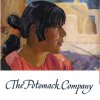







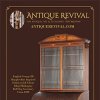

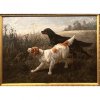



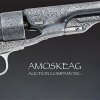
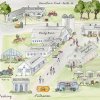


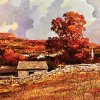
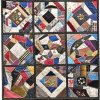






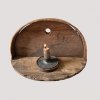





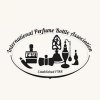

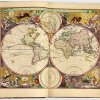

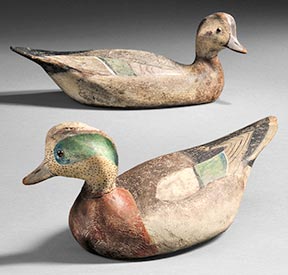
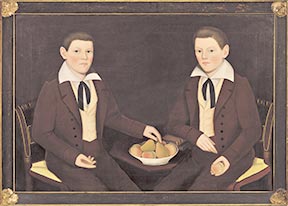
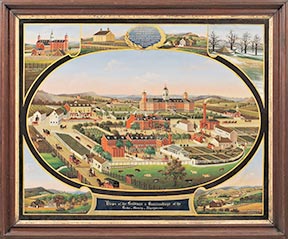
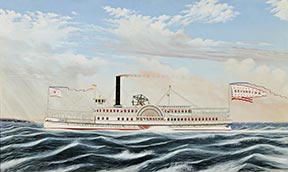
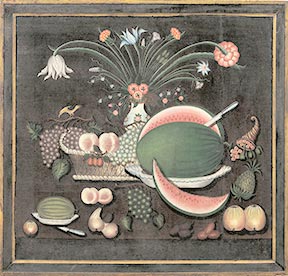
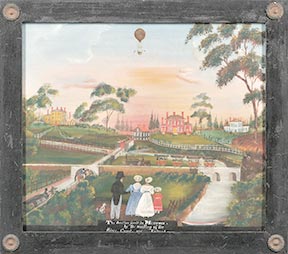
 This 1730-60 New Hampshire banister-back side chair with carved crest is probably a Portsmouth product. It has a wonderful surface of a very dry old black paint over a red color. Estimated at $6000/8000, it sold for $19,200.
This 1730-60 New Hampshire banister-back side chair with carved crest is probably a Portsmouth product. It has a wonderful surface of a very dry old black paint over a red color. Estimated at $6000/8000, it sold for $19,200.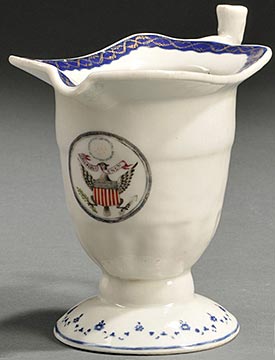 One Chinese export offering absolutely demolished its $800/1200 estimate. “It was brought in by a walk-in consignor on one of our appraisal days in Boston,” Steve Fletcher explained. “He said his father collected things with eagles painted on them.” The object was a Chinese export porcelain helmet-shaped creamer with simulated cane handles and some minor paint loss. The eagle was painted at the center of the Great Seal of the United States. Besides being a fairly rare form, the seal identifies the creamer as possibly from the tea service ordered by Henry Smith, who went to Canton aboard the ship George Washington in 1794. Other pieces from that service are in the collections of the Peabody Essex Museum, Washington and Lee University, and Winterthur. The phone bids were strong, but a left bid was stronger yet. Steve Fletcher hammered it down for $39,000 (including buyer’s premium).
One Chinese export offering absolutely demolished its $800/1200 estimate. “It was brought in by a walk-in consignor on one of our appraisal days in Boston,” Steve Fletcher explained. “He said his father collected things with eagles painted on them.” The object was a Chinese export porcelain helmet-shaped creamer with simulated cane handles and some minor paint loss. The eagle was painted at the center of the Great Seal of the United States. Besides being a fairly rare form, the seal identifies the creamer as possibly from the tea service ordered by Henry Smith, who went to Canton aboard the ship George Washington in 1794. Other pieces from that service are in the collections of the Peabody Essex Museum, Washington and Lee University, and Winterthur. The phone bids were strong, but a left bid was stronger yet. Steve Fletcher hammered it down for $39,000 (including buyer’s premium).

